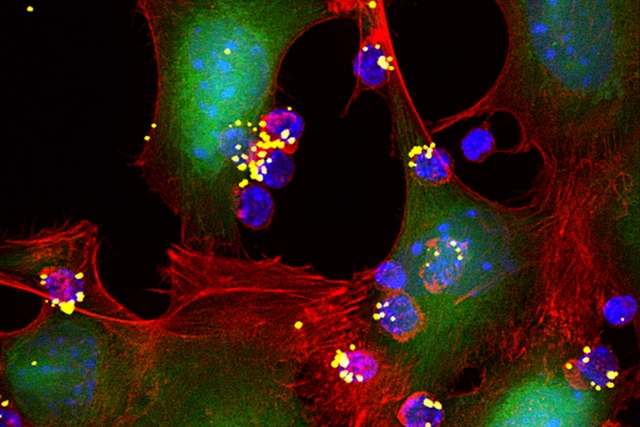
Micrograph showing cytokines, seen as yellow circles, activating T-cells, in blue, to attack nearby tumor cells. (Sudha Kumari and Yiran Zheng, Mass. Institute of Technology)
10 July 2018. A bioengineering lab developed a technique to attach larger quantities of cancer-fighting proteins to immune system cells that in lab mice reduced or eliminated tumors while avoiding harmful side effects. A team at Massachusetts Institute of Technology describes the technology in yesterday’s issue of the journal Nature Biotechnology (paid subscription required).
Researchers from the lab of bioengineering and materials science professor Darrell Irvine are seeking more effective and safer methods for harnessing the immune system to treat cancer. Engineering T-cells, white blood cells in the immune system, to fight cancer today involves adding protein receptors that seek out and destroy cancer cells. While this approach often returns high remission rates for some blood-related cancers like leukemia, it has proven more difficult with solid tumors, such as breast or lung cancer. Techniques to boost the technique’s effectiveness, such as adding immune system proteins called cytokines, can also result in harmful immune reactions, such as inflammation.
Irvine’s lab studies ways of improving the effectiveness of cancer treatments with synthetic materials formulated into nanoscale particles, where 1 nanometer equals 1 billionth of a meter. Researchers in the lab investigate ways nanoparticles can be configured to locate the therapies’ targets, deliver the treatments to those targets, or amplify their effects when encountering tumor cells.
In this case, the team formulated gel-like nanoparticles that absorb relatively large quantities of the cancer-fighting cytokine interleukin-15 carried by T-cells. The nanogel particles are also designed to release their interleukin-15 payloads only after binding to the tumor cells, by reacting to chemical changes unique to T-cells when they encounter tumors, thus preventing adverse side effects when extra cytokines are released into the general blood stream.
“The nanogels are preferentially dissolving when the T-cells are in sites where they see tumor antigen, in the tumor and in the tumor-draining lymph nodes,” says Irvine in a university statement. “The drug is most efficiently being released at the sites where you want it and not in some healthy tissue where it might cause trouble.”
The researchers tested the techniques in lab mice induced with melanoma, an aggressive form of skin cancer. The results show the nanogels could release 8 times the amount of interleukin-15 without causing adverse effects in the mice, than the same cytokines given by injection into the blood stream. The findings also show the technique enables T-cells to expand 16-fold in the mice tumors, causing reductions in tumor size, and in 60 percent of the cases, complete elimination of the tumors.
Irvine is a founder of Torque Biotherapeutics a start-up enterprise in Cambridge, Massachusetts that licenses the technology from MIT, and chairs the company’s scientific advisory board. Torque offers what it calls deep-primed T-cells that address a variety of blood-related and solid-tumor cancers, with interleuken-15 and other immunotherapies. The company expects the procedures for deep-primed T-cells to be simple enough for administering in an outpatient setting. The university says Torque plans to begin clinical trials of its technology this summer.
More from Science & Enterprise:
- Nanoscale Cell-Like Robots Shown to Clean Blood
- Patent Awarded for Nasal Delivered Cancer Immunotherapy
- Nanotech Pain Drug Formulations Developed
- Patent Awarded for Nanoparticle Drug, Cannabis Delivery
- Peptide Hydrogel Boosts Cancer Immunotherapies
* * *

 RSS - Posts
RSS - Posts
[…] Nanoparticles Shown to Boost Anti-Cancer Immune Cells […]